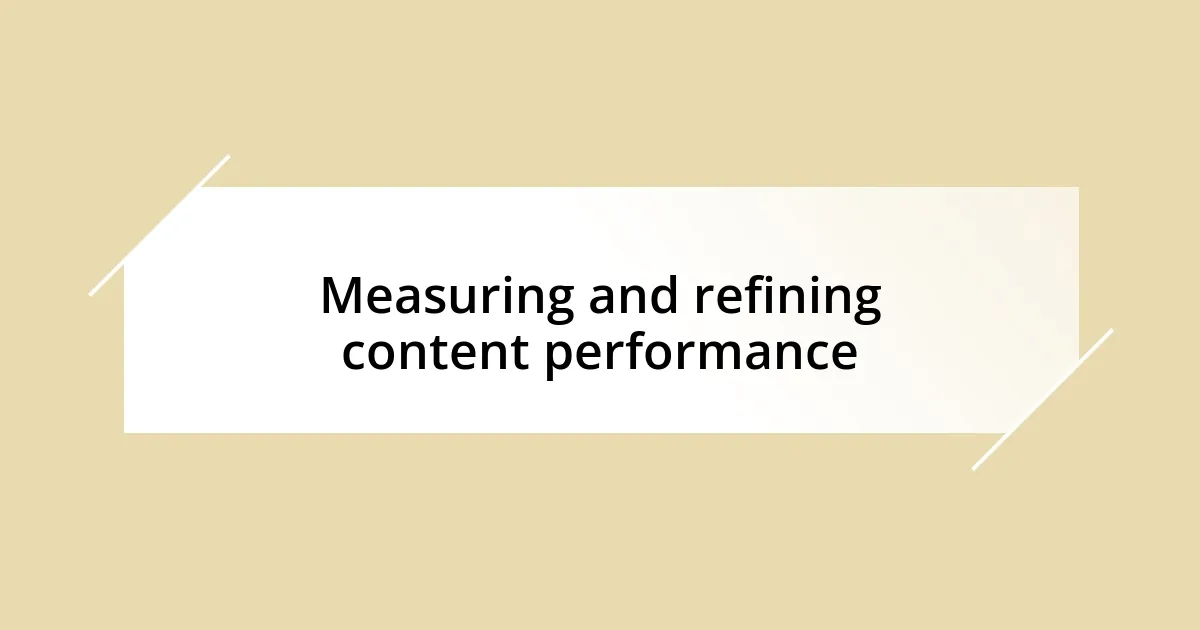Key takeaways:
- Emphasizing clarity and brevity in online writing is essential, as readers tend to skim content and prefer engaging formats.
- Identifying and understanding the target audience through surveys, data analysis, and community involvement enhances writing relevance and connection.
- Incorporating multimedia elements, such as images and videos, can significantly boost reader engagement when chosen carefully and aligned with the content.
- Measuring content performance through analytics allows writers to refine their strategies and adapt to audience preferences effectively.

Understanding online writing needs
When I first ventured into online writing, I quickly realized that readers have different expectations compared to traditional formats. They skim, scan, and often multitask, so crafting concise, punchy content became essential. Have you ever found yourself clicking away from a wall of text? I know I have. That’s when it hit me: clarity and brevity are not just preferences; they’re necessities.
Engagement plays a crucial role in online writing. I remember experimenting with a few conversational hooks in my articles and was surprised how they transformed reader interactions. It felt like inviting my audience into a friendly chat rather than lecturing them from a podium. Have you ever stopped to consider how a casual tone can build rapport? That connection can foster loyalty and keep readers returning for more.
Visual elements also matter. I began integrating images and bullet points to break up the text, and I noticed a significant increase in reader retention. It’s fascinating how our brains respond to a well-formatted page, isn’t it? For me, embracing these visual cues helped convey meaning effectively, ensuring that my insights weren’t lost in a sea of words.

Identifying target audience effectively
Identifying my target audience effectively was a game-changer in my writing journey. Initially, I had a vague sense of who might read my content, which led to some disconnect. However, I took the time to create detailed reader personas, thinking about their interests, demographics, and challenges. This approach gave me clarity and allowed me to tailor my writing in ways that truly resonated. I remember the moment I received feedback from a reader who said my article spoke directly to their experience—it was incredibly rewarding and confirmed I was on the right path.
To pinpoint my target audience, I focused on several key strategies:
- Conduct Surveys: I reached out to my readers and asked simple questions about their preferences.
- Analyze Engagement Data: I reviewed metrics like page views and comments to see which topics sparked the most interest.
- Join Relevant Communities: I immersed myself in online forums and platforms where my ideal audience hangs out, noting their language and concerns.
- Experiment with Content Styles: I tried different tones and formats to see what resonated best, paying attention to reader reactions.
Understanding my audience wasn’t just a one-time task; it became an ongoing dialogue that continually shapes my writing approach.

Adapting tone and style
Adapting tone and style for online platforms involved a significant shift in my writing perspective. Early on, I tended to get lost in elaborate descriptions and intricate ideas, believing that more words equated to deeper insights. However, I quickly realized that less can be more. My breakthrough came when I crafted a short, witty piece that got an unexpected surge in shares. That taught me the value of a relatable tone, which feels genuine and approachable. Who would have thought that a touch of humor could capture attention so effectively?
I’ve also learned that varying my tone according to the subject matter engages readers more effectively. For instance, when discussing a serious topic, I maintain professionalism while still adding personal anecdotes to humanize my writing. Conversely, when I talk about lighter subjects, I lean into a more relaxed, conversational style. This strategy keeps readers intrigued, as they can feel the shift in voice depending on the content. Have you noticed how different tones influence your mood while reading? It’s fascinating how emotional resonance can impact our engagement levels.
To provide a clearer comparison of styles, I created the following table to illustrate these differences:
| Traditional writing style | Online writing style |
|---|---|
| Formal and elaborate | Concise and engaging |
| Descriptive and complex | Simple and clear |
| One-way communication | Conversational and interactive |
| Lengthy paragraphs | Short paragraphs with visuals |

Utilizing SEO and keywords
Utilizing SEO and keywords transformed my writing strategy in ways I didn’t initially anticipate. I used to avoid using specific terms, thinking they would make my writing sound robotic or forced. But then I discovered the power of integrating relevant keywords naturally into my content. It was a revelation! I remember the first time I tracked how using the right keywords boosted my article’s visibility. It felt like unlocking a door to a whole new audience.
One technique that resonated with me was keyword research, an essential step I hadn’t prioritized before. I began using tools like Google Keyword Planner and Ubersuggest to identify terms my audience was searching for. This proactive approach made my writing more relevant and audience-focused. I still smile when I think about the sense of purpose I felt as the traffic to one of my articles surged. A simple change in wording had such a profound impact—who knew?
However, I learned the importance of not overstuffing my content with keywords. It’s crucial to maintain the flow and coherence of my writing while ensuring it’s optimized for search engines. I often ask myself, “Does this feel natural?” If it feels forced, I adjust my phrasing until it aligns seamlessly. Striving for that balance became key in my writing evolution, allowing me to engage my audience while also drawing them in via search engines. The results were tangible; my engagement levels soared, and I felt a sense of accomplishment every time I saw the impact of these adjustments.

Incorporating multimedia elements
Incorporating multimedia elements into my writing has been a game-changer. Initially, I was hesitant—wondering if images and videos would distract readers rather than enhance my message. But when I started adding relevant visuals, I noticed a remarkable shift in engagement. One particular post featuring infographics not only explained complex data but also sparked lively discussions in the comments. It was a great reminder of the power of a well-placed image.
I also discovered that videos can create a deeper connection with my audience. I remember crafting a piece where I shared a personal story through a short video. The feedback was overwhelming; readers appreciated seeing my expression and hearing my voice. It felt more intimate and real, bridging the gap between writer and reader. Isn’t it fascinating how multi-sensory experiences can enrich our understanding?
Lastly, I emphasize the importance of choosing multimedia elements that complement rather than overwhelm the text. There was a time when I got carried away, inserting too many elements in one article. The result? A cluttered layout that confused rather than informed. Now, I carefully curate visuals that support my narrative and enhance comprehension, ensuring a streamlined reading experience. After all, what good are multimedia tools if they don’t serve to clarify and amplify the message?

Creating engaging headlines
Creating compelling headlines has become a cornerstone of my writing journey. At first, I thought a catchy phrase alone would suffice, but I quickly discovered the importance of clarity alongside creativity. There’s something exhilarating about crafting a headline that perfectly encapsulates my article while piquing curiosity. I remember brainstorming different options for a piece about travel tips—some fell flat, but when I finally hit on “Secrets to Traveling Like a Local,” I felt a surge of excitement. It not only resonated with my audience but also set the tone for the engaging content that followed.
One technique I embraced was the use of numbers and questions in my headlines; they seem to naturally draw readers in! For example, “5 Must-Know Hacks for a Stress-Free Trip” turned out to be a fan favorite. The combination of a promise and a specific number feels almost like an invitation. I often ask myself, “Would I click on this?” If the answer is no, I know I need to iterate further. This little exercise has turned my writing process into a more interactive experience, not only for me but for my readers as well.
I also learned the power of emotion in a headline. I experimented with different phrases and found that evoking feelings could truly grab attention. For instance, changing “Tips for Booking Flights” to “How to Avoid the Nightmare of Overpriced Flights” suddenly made the topic personal and urgent. Emotions connected readers to my content—who wouldn’t want to escape a nightmare, right? It’s incredible how just a word or two can turn a simple statement into a passionate call to action, ensuring my audience feels compelled to dive into the full article.

Measuring and refining content performance
Measuring content performance is essential for refining my writing strategies. I often dive into analytics to see how my articles resonate with readers. One time, I posted a piece that I thought was fabulous, but the metrics told a different story. The bounce rate was high, and I couldn’t help but ask myself, “What went wrong?” After reviewing the feedback and engagement stats, I realized I hadn’t fully captured the reader’s interest right from the start.
When evaluating performance, I pay close attention to engagement metrics like comments and shares. A more recent article about remote work trends sparked an unexpected flood of reactions, inspiring me to explore this topic further. I felt a surge of excitement realizing how much people connected with my insights. This experience taught me the importance of listening to my audience. Their responses provide a roadmap, guiding me toward subjects they genuinely care about.
Refining my content based on these insights has become a crucial practice. I remember taking a week to revisit an underperforming post about mindfulness techniques, and with some adjustments—adding clearer headings and more relatable examples—the second time around, it soared! I always ask myself, “What do my readers really want?” Diving deep into analytics and audience feedback helps ensure that my content continues to evolve meaningfully and authentically.














